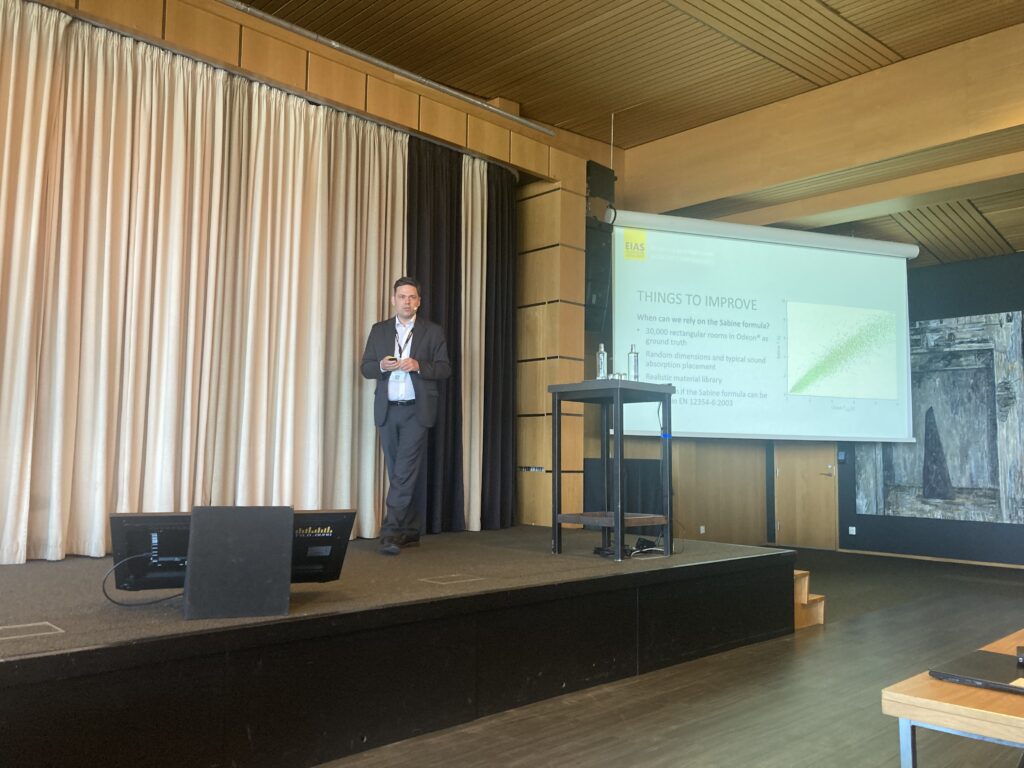
Standardization in Room Acoustics
Room acoustics and electroacoustic systems are critical components of building design that can impact the quality of sound and speech intelligibility in various environments, from concert halls to classrooms and offices. In Hungary, the journey towards standardization in this area began over a century ago, but it wasn’t until 2020 that the country saw the release of its first room acoustics standard.
This standard, along with another one containing requirements for electroacoustic systems, was the result of four years of development and has had a significant impact on the quality of room acoustics in the country. In this article, we speak with Csaba Huszty, a leading expert in the field of room acoustics and one of the key players involved in the standardization process, to learn more about Hungary’s journey towards standardization in this area, the challenges faced during the process, and the impact of the standards on the quality of room acoustics in the country. We also explore potential future directions for room acoustics and electroacoustic system standards in Hungary and what lessons can be learned from Hungary’s experience in this area.
What prompted Hungary to develop its first room acoustics and electroacoustic standards after a century of standardization efforts?
Awareness of room acoustics and electroacoustics has been on a constant increase in the last decades both among clients and architects, yet the adoption and coverage of building acoustics, and the scientific approach in development projects had to be significantly improved especially when the pace of modernization efforts and ongoing projects nationwide was considered. When I moved back to Hungary from Japan, I thought we were missing a lot of opportunities in Hungary to build higher quality and the reason was the lack of related standards. Consequences were not only related to missing universal design approaches, inclusion or not avoiding detrimental health effects, but also very much to reduced competitiveness. And the buildings will be with us, likely more or less unchanged for decades. A classroom without proper sound absorption and diffusion is very likely not going to work and students and teachers in there will underperform. Many people knew this but there was no standard acting as a protective shield at various stages of the construction project. At the time this standard was initiated, many large-scale projects were about to start in Hungary and it was just the right time, if not too late, and a necessity, to have a standard.
Can you describe the four-year development process for these standards, and who were the key players involved?
The standardisation process in case of national standards requires two key ingredients: a text draft and a contract securing funding. Since standards are generally the product of the private sector, this national standard was not coming from the initiative of the government, but came from our own small consultancy firm. As a special circumstance, we also had to revitalize the committee where room acoustics was about to be discussed as there was quite some silence since 2007, no pun intended, when the building acoustics standards got a major refresh. The standardisation process involves developing and then hopefully accepting an initial draft the funder is proposing. First, the committee has to accept the standard into the working programme but since we started with a new, for-purpose ad hoc committee, we could start working on the development of the draft immediately.
Both the room acoustics and electroacoustics standards are requirement kind of standards. They are defined on a national level so there is no harmonization among the requirements in EU countries, yet and each member state may define its own requirements for what it thinks a good classroom or ward must sound like. Or, how it must not sound like, since the Hungarian standard contains limits instead of target values. The actual targets for each project must be set by the stakeholders preferably with the assistance of an acoustic consultant. In the standardisation process, practically all practicing acoustic consultants in the field were invited, and most of them, indeed, voluntarily participated. Many of them were actually involved in most of the committee meetings so the activity and involvement was high. This resulted in a lengthy and challenging process of agreement, but a very short adoption time: by the time the standard was released, the majority of the consultants were already aware of its contents and ideas behind.
How did the adoption of the ISO open office standard impact the national building code and mandatory requirements for room acoustics?
The open office standard has been adopted and added as-is into the pool of national standards and now it has the same status as any other building acoustics standard: it is de facto mandatory. For open offices this means that we now have two room acoustic standards and in case sound masking is used, the electroacoustic standard also has additional requirements. At the decree level of our building code acoustic standards are referenced as solutions with which the basic requirements of buildings can be effectively fulfilled and this is why these standards have become de facto mandatory.
If one decides to diverge from the standard, equivalence must be documented and for requirements type standards, differing shall mean applying better or equivalent limits. Many of the values in the standards, also in the Hungarian one, is currently based on considerations of the Sabine equation but it is also widely known that applicability is very limited of this equation for ordinary rooms. Therefore we launched a research project to systematically address this phenomena and find applicability limites using new methods such as machine learning, and I hope its results will be soon incorporated in the update of the standard.
What were some of the key challenges faced during the standardization process, and how were they overcome?
We had multiple challenges and there were several points in time where the standardisation process was close to failing. Most of the differences that had to be aligned had a few common features and root causes. It is important to mention that these two standards had no precedence in Hungary. There were not even recommendations or other supportive documents guiding the stakeholders on what practices will work.
Building acoustics education in Hungary was sporadic and the accessible acoustic curriculum offer no direct path towards becoming a building acoustics consultant. Consequently, currently practicing consultants taking part in the process had very diverse backgrounds and experience. Since the last book on room acoustics in Hungarian language was published in 1986 and there were no building acoustic consultant companies employing more than 3 people, new generations of consultants have had difficult times to emerge.
The digital skills of acoustic consultants were also shown to be diverse and the software infrastructure, also due to economic constraints, was also limited. This practically meant that consultants had a wide range of differing opinions whether room acoustic parameters requiring computer modeling such as STI, C50 or G could be applicable or not for ordinary spaces for the time being. One path to partially resolve this issue is to use quantity-based requirements, for example of equivalent absorption and leave the usage of other parameters as recommendations while noting that reverberation time and absorption is not depicting the full picture of acoustic quality.
How have these standards affected the quality of room acoustics in Hungary, and what measurable improvements have been seen since their implementation?
I would like to believe that there was a significant change, but we have no nationwide surveys that I am aware of describing the room acoustic conditions of spaces before or after the standard, so we really do not know. Still, the probability of successful room acoustic implementations are very likely much higher, and in the projects where we are involved as consultants, we have to spend less time on convincing the stakeholders of the necessities. I also increasingly see requirement documentations explicitly referring to these standards which is a good sign of adoption. But there is still much work ahead of us to improve quality control throughout the entire development process, and many smaller scale and fitout projects do not involve authorities or administrative procedures, and there, it is still easy for priorities to change.

What lessons have been learned from the standardization process, and how can other countries learn from Hungary’s experience in this area?
One of the lessons I have learnt is a ‘yes-you-can’ experience, namely that there is no need to wait for governments or someone else to create a room acoustic requirement standard, but private entities, even SMEs can also be successful in developing them. I have also learned many lessons about the state of the market during the process, and one of the most important revelations was that implementing great room acoustics is much more a matter of priorities than costs, and arguments that room acoustics is expensive are simply missing the point. This also means that when setting up room acoustic requirements, one really should aim for great quality.
How have these standards affected the electroacoustic system industry in Hungary, and what new developments have emerged as a result of the standards?
The electroacoustic standard is covering STI and sound pressure level requirements of PA systems and set up sound masking systems in buildings not to be too intrusive. There are very few examples of sound masking systems, but quite a few PA systems are being built in transportation, schools, outdoors and in other premises. Requirements serve the purpose of making sound systems intelligible while being not too loud to take into account the requirements of an aging society and to protect the hearing of young people. Some requirements were also recently added to relevant laws, for example, to limit sound exposure in schools during an amplified music event. The electroacoustic standard is I think very important part of our standards system and there are very few examples of such even in more developed countries.
How have architects and building engineers responded to the new standards, and have they faced any challenges in implementing them in their designs?
So far I have only seen positive responses, but raising awareness is still an ongoing work. The two most important challenges right now is to increase the coverage of adoption and reduce the number of projects where compliance cannot be assured since there is no licensed acoustical consultant involved, and secondly to create the framework for better quality control after the design phase have finished. The new standards have already contributed to better priority alignments in many projects.
How has the Hungarian government supported the adoption and implementation of these standards, and what role have they played in promoting their use?
Shortly after the standards have been released, the Hungarian government modified the corresponding law and made the application of these standards de facto mandatory. This was a major support for the adoption of the standards and the ambiguity if these standards are voluntary of mandatory was resolved. Additionally, an increasing number of public projects are now requiring as early as in the competition phase for the design, for a licensed acoustician to be involved in the process. This will hopefully deepen the coverage of better acoustic designs.
What are some of the potential future directions for room acoustics and electroacoustic system standards in Hungary, and how can they continue to improve the quality of building acoustics in the country?
I think the barrier of entry of acoustic design is gradually getting lower by the advancements of new technologies and software, and this allows adding more complex room acoustic parameters and prediction methods into the standards by still maintaining cost efficiency in the consulting effort. I am particularly thinking of the application of AI and machine learning methods offering the potential replacements of statistical equations at scenarios where traditional computer modeling by geometrical or numerical methods would be too expensive or slow. For example, in case of designing rectangular rooms with uneven absorption. Some of these methods and corresponding parameters may be needed to be adopted into these standards in the near future. I also hope to see more focus and advanced acoustical requirements in educational premises, perhaps even harmonization on a regional scale. For the purpose of a wider adoption of the standards, I very much look forward to deepening the processes of quality control.

Watch the full presentation here and read more about EIAS 2023 here!

